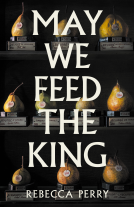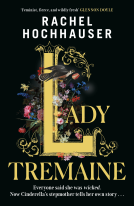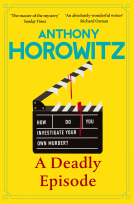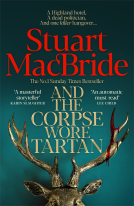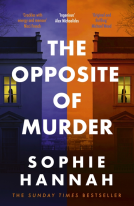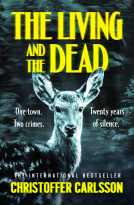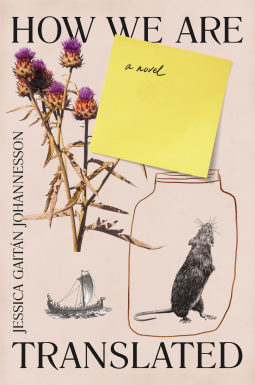
How We Are Translated
by Jessica Gaitán Johannesson
This title was previously available on NetGalley and is now archived.
Send NetGalley books directly to your Kindle or Kindle app
1
To read on a Kindle or Kindle app, please add kindle@netgalley.com as an approved email address to receive files in your Amazon account. Click here for step-by-step instructions.
2
Also find your Kindle email address within your Amazon account, and enter it here.
Pub Date 2 Feb 2021 | Archive Date 31 Jan 2021
Scribe UK | Scribe
Talking about this book? Use #HowWeAreTranslated #NetGalley. More hashtag tips!
Description
LONGLISTED FOR THE DESMOND ELLIOTT PRIZE
People say ‘I’m sorry’ all the time when it can mean both ‘I’m sorry I hurt you’ and ‘I’m sorry someone else did something I have nothing to do with’. It’s like the English language gave up on trying to find a word for sympathy which wasn’t also the word for guilt.
Swedish immigrant Kristin won’t talk about the Project growing inside her. Her Brazilian-born Scottish boyfriend Ciaran won’t speak English at all; he is trying to immerse himself in a Swedish språkbad language bath, to prepare for their future, whatever the fick that means. Their Edinburgh flat is starting to feel very small.
As this young couple is forced to confront the thing that they are both avoiding, they must reckon with the bigger questions of the world outside, and their places in it.
A Note From the Publisher
Please note that this text is uncorrected and subject to change.
Advance Praise
‘How We Are Translated is the most contemporary of novels; set somehow both in the now and in the distant past; in one city that could be many cities, and in two different languages, though also in defiance of language, with as much focus on the silences between words as the words themselves. It’s a novel that maintains just the right balance of oddity, intimacy and illumination. It’s a novel that anyone interested in the future of the English novel needs to read!’
— Sara Baume, author of Spill Simmer Falter Wither
‘With echoes of Ali Smith and George Saunders, How We Are Translated explores themes of identity and intimacy with admirable sensitivity and wit.’
— Julianne Pachico, author of The Anthill
‘How We Are Translated is one of the gentlest and most patient, humane, and quirky things I have read in a long time: its speculative elements are like fond digressions that grow more substantial — the Translation Room being my favourite, somewhere between a hiding space and a wardrobe leading to Narnia — and more believable as you read. It’s really a story about love in its gentlest form. The language difference, which isn’t really a difference but a slowing-down and fond skewing of communication between people, means it’s also always a little bit out-of-focus, or weird, which is somehow unnerving in the sweetest way. Hugely original.’
— Niamh Campbell, author of This Happy
‘Our bodies and languages are made new to us again through Jessica Gaitán Johannesson’s wild and playful novel. Laying bare the absurdity of the idea of a common tongue, she takes us on an adventure through private and public languages — those which ebb and flow between lovers or arise out of necessity in a workplace obsessed with authenticity. How We Are Translated gets at the heart of how language holds us, tears at us, and can bring us close in spite of, or because of, its inevitable imperfections.’
— Saskia Vogel, author of Permission
‘How We Are Translated is a layered work about home, language, barriers, and belonging. Johannesson’s unusual and refreshing prose crackles with truth — burning along beautifully.’
— Alice Bishop, author of A Constant Hum
Available Editions
| EDITION | Ebook |
| ISBN | 9781925938784 |
| PRICE | US$31.99 (USD) |
| PAGES | 240 |
Links
Average rating from 54 members
Featured Reviews
Well this book is absolutely bloomin lovely! The writing style is my absolute favourite. It’s the tiny details and fascinating observations. So many quirks! Oh, the quirks. I’ve genuinely never loved characters more than this couple. (Even the acknowledgment page is lovely, that’s how far I wanted to keep reading!)
It’s written from the perspective of 24-year-old Kristin, a Swedish immigrant living with her Black boyfriend, Ciaran, in Edinburgh. It’s written almost as her diary to him. She writes “you said” and “you were” when talking about him, and she dissects the languages of both English and Swedish throughout. This somehow highlights their differences, struggles and harmonies perfectly, as they try to navigate through their thoughts and feelings to each other.
When we meet them they are 4 years into their relationship and they’re so different yet so in love. It’s beautiful the way Kristin studies Ciaran‘s actions and his body, you can feel the love seeping from the pages, even when she’s talking about his knobbly knees. It’s the way she hopes she’ll see his beard turn grey one day and that his creaky sinuses are nothing serious. They drive each other nuts, they overthink constantly, and I love them so, so much.
Picking a single favourite quote is impossible here. For the first time ever I’m doing 3:
“At about eleven pm I set about looking up all the old school friends I could find online to check if any of them had died or become neo-Nazis. You were getting ready for bed.”
“The end of July has always been my least favourite time of year anyway, because it sits in the throat of summer and refuses to be swallowed.”
“It’s a shame we don’t write emails to each other anymore. I liked re-reading the best things you say. I’m up for being a grown up with you, you wrote once. As if I’d asked you to give ficking pottery a go.”
Please let there be a second book coming. I need more of this!
How We Are Translated is out on the 2nd February 2021, thank you so much to Scribe UK for the arc!
 Michaela J, Reviewer
Michaela J, Reviewer
This is a quirky book that took me a little while to get it's rythym. Kristin, a Swedish woman, lives with Ciaran in Edinburgh. By day she is Solveig, part of Edinburgh Castles living history exhibit.
Ciaran is one of those people who throws himself into his projects. He decides he wants to learn Swedish and will only speak Swedish at home. For some reason this irritates Kristen, who then avoids helping him wherever possible. She also finds out she is pregnant.
The whole book is written from her viewpoint and we come across the strange and eclectic characters who are part of her life. Joanne Tarbuck, her boss, Ingrid and Algot who are her co-workers in the exhibit. The Lithuanians, the Irish and the odd bods around her home.
A strange book, but it drew me in and I enjoyed it.
 Reviewer 632489
Reviewer 632489
I love reading books about other languages, or with parts written in other languages, even though it makes me feel like I should try to pick up my Spanish again, or that I should remember any French vocab at all. Only speaking one language is really very boring. Ha.
How We Are Translated is about a couple living in Edinburgh; 24-year-old Kristin, who immigrated from Sweden five years ago, and her boyfriend Ciaran, who grew up in Scotland after being adopted from Brazil as a toddler. A potential pregnancy means that their relationship is shifting into something neither of them feels quite adult enough for, and they both deal with it in different ways. Kristin throws herself into her job, as a living history exhibition at the Castle, allowed to speak only in Swedish during working hours, playing the character of Solveig, the Viking’s wife. Ciaran decides that he will learn Swedish to better understand Kristin, immersing himself in a språkbad language bath, covering their small flat with post-its and reading newspapers he doesn’t yet understand.
I loved Kristin’s interactions at her job and how her job bled into her life outside of it, the way that it made her native language — a language she doesn’t share with anyone immediately around her — feel like a job in itself. The book is written mostly in the second person, as Kristin addresses her thoughts throughout the day towards Ciaran. It’s full of small observations which make both Kristin and whoever she’s talking about feel more fully realised, and the little bilingual segments add another layer to the relationships between characters.
I really enjoyed this — and can we just have a moment to bask in that BEAUTIFUL cover?
Out in February, thanks @scribe_uk & #netgalley for the early copy!
 Rebekah L, Reviewer
Rebekah L, Reviewer
Kristen is a Swedish young woman living in Edinburgh with a Scottish man of Brazilian heritage. She works in the Castle Museum, the National Museum of Immigration, that celebrates the history of Scotland by providing a living exhibition of all the peoples who have contributed to Scottish history. She is part of the Nordic peoples exhibition, a Norse woman who came with the raiders to find a new place to farm. Her team speak Icelandic, which she doesn’t understand, and Norwegian of which she understands a little. They aren’t allowed to speak English during their shifts, not even with colleagues who don’t understand them.
As the novel opens, Kristen’s partner who is training to be a nurse, has decided to take a break and immerse himself in a new project: learning Swedish. He is so dedicated he refuses to speak English. Though it’s her language, this shuts Kristen out.
In amongst all of these translations, are the mutable shifts of her body that carry her from child to adult to possible parent, for Kristen is pregnant. The subject is avoided. More time is spent thinking about how languages use words in ways that hold a nuanced vision of the world. More time is spent thinking about who will lead the museum’s parade through the Edinburgh festival. More time is spent staring at the preserved animals in her partner’s jars, a hobby he picked up as a child.
There are some thoroughly enjoyable contemplations of the meanings of words and phrases:
People say ‘I’m sorry’ all the time when it can mean both ‘I’m sorry I hurt you’ and ‘I’m sorry someone else did something I have nothing to do with’. It’s like the English language gave up on trying to find a word for sympathy which wasn’t also a word for guilt.
There is a quiet defiance over the ongoing ways in which we interpret others through our understanding of their skin colour, gestures, language, clothing, hair, job, hobbies. There is a desire for people to try and break down the ways in which they view these translations from a specific viewpoint that has its own biases and social expectations. And in the middle of these larger unpickings there is a very specific story about a young couple attempting to find their own way through life amidst the confusing displays of behaviour dramatised around them.
Meticulous, sometimes bewildering, How We Are Translated is a quirky coming of age novel that lives, loves and questions our multicultural world.
How We Are Translated by Jessica Gaitán Johannesson is all about incommunicability.
This topic is presented on multiple levels. Let’s start from the title.
If we need to be translated it means that whatever we say has no meaning for who receives the message unless our words are transferred into another language. We coul be able to successfully convey the meaning but there is always something lost in translation from language A to language B.
In the novel the main character is Swedish and her partner was born in Brazil but grew up in Scotland. One speaks Swedish, the other speaks Portuguese, and they meet in the middle ground that is the English language until he decides to stop using English to start an immersive learning of Swedish, being unable to properly communicate in that language.
Stepping into the novel, the first thing we learn from the voice narrating us the story is that she is not speaking to her partner, or that he is not speaking to her anymore. We are faced with a lack of communication between them, the key component in a fully functioning relationship.
Our protagonist works in the fictional National Museum of Immigration in Edinburgh, where all the peoples that have come to Scotland and have left a mark across the centuries are on display. She is one of the Vikings who have come to the Scottish shores in the 15th century. While on shift, the employees are forbidden from using English with each other so they end up saying things in their own languages but they are left unable to understand any of it.
Johannesson touches other topics as well, such as migration, xenophobia, relationship issues and parenthood.
The museum should celebrate the arrival of different peoples to Scotland as they brought innovation and contributed to the cultural canvas that we can now find in the country; instead, the same employees have rivalries and are ready to suspect certain groups based on stereotypes and prejudices; they fear the arrival of new peoples in the museum to be represented with their own installation as they would take up some of their space.
Two young people with stable jobs, although not great, are able to become a family? To become parents? Will their languages always be a barrier between them, preventing to fully understand each other?
Moving on to the style, How We Are Translated is a pleasant novelty that explores linguistics in different ways.
We can find some experimentalism where the author tries to show a parallel between English and Swedish but we also have some thoughts expressed by the protagonist that could easily be relatable for anyone coming to the UK from a different country:
“People say ‘I’m sorry all the time when it can mean both ‘I’m sorry I hurt you’ and ‘I’m sorry someone else did something I have nothing to do with’. It’s like the English language gave up on trying to find a word for sympathy which wasn’t also the word for guilt.”
Don’t we all feel like the things we say sometimes lose part of the meaning we give them when we speak them out loud? Why is it so? If not answers, this book will spark some brilliant considerations in the reader’s mind.
 Roberta C, Educator
Roberta C, Educator
This was a really interesting book. Kristen and Ciaran, both immigrants to Scotland, live in Edinburgh, where she works at a fictional Museum of Immigration.
Her work is an escape from thinking too hard about the fact she has just discovered she is pregnant, whereas her Brazilian/ adopted Scottish partner Ciaran is dealing with it by trying to learn Swedish. Much of the book involves disjointed pieces of Swedish/ English translation that are interesting to read, but interrupt the flow of the book a bit.
At the museum, international tensions are played out as the different cultures (all European) that have their own exhibits are set against each other, while more recent immigrant groups like Pakistan are ignored. The strange, ineffectual manager insists that each employee speaks only their native language, which means that most of them cannot communicate with each other. This of course leads to strange and farcical situations, like the Latvians discovering the Viking house is going to have a fake pregnancy storyline, so they all appear the next day wearing fake bellies.
It was a strange mixture of realistic and weird, and I found it hard to work out exactly what was going on. It fairly accurately represented the feeling of being in a foreign country and culture, and not being quite sure of what everyone was trying to say! A very unusual book, and one I will remember.
Readers who liked this book also liked:
Robert Thorogood
General Fiction (Adult), Mystery & Thrillers, Women's Fiction
